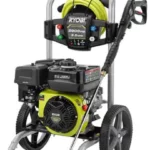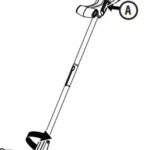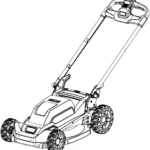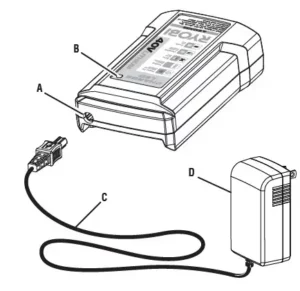
RYOBI OP404 40v Lithium Ion Battery Charger

WARNING: To reduce the risk of injury, the user must read and understand the operator’s manual before using this product.
SAFETY RULES FOR CHARGER
WARNING!
READ AND UNDERSTAND ALL INSTRUCTIONS. Failure to follow all instructions listed below, may result in electric shock, fire and/or serious personal injury.
- Before using charger, read all instructions and cautionary markings in this manual, on charger, battery, and product using battery to prevent misuse of the products and possible injury or damage.
- Charge only one lithium-ion rechargeable battery at a time. Other types of batteries may burst, causing personal injury or damage. For compatible battery packs see tool/appliance/battery pack/charger correlation supplement 988000-842.
- Do not use charger outdoors or expose to wet or damp conditions. Water entering charger will increase the risk of electric shock
- Do not charge a battery that is wet or has been wet or exposed to liquids.
- Use of an attachment not recommended or sold by the battery charger manufacturer may result in a risk of fire, electric shock, or injury to persons. Following this rule will reduce the risk of electric shock, fire, or serious personal injury.
- Do not abuse cord or charger. Never use the cord to carry the charger. Do not pull the charger cord rather than the plug when disconnecting from receptacle. Damage to the cord or charger could occur and create an electric shock hazard. If cord or charger is damaged, have the charger replaced by an authorized serviceman.
- Make sure cord is located so that it will not be stepped on, tripped over, come in contact with sharp edges or moving parts or otherwise subjected to damage or stress. This will reduce the risk of accidental falls, which could cause injury, and damage to the cord, which could result in electric shock.
- Keep cord and charger from heat to prevent damage to housing or internal parts.
- Do not let gasoline, oils, petroleum-based products, etc. come in contact with plastic parts. They contain chemicals that can damage, weaken, or destroy plastic.
- Always wear eye protection with side shields marked to comply with ANSI Z87.1. Failure to do so could result in objects being thrown into your eyes resulting in possible serious injury.
- An extension cord should not be used unless absolutely necessary. Use of improper extension cord could result in a risk of fire and electric shock. If extension cord must be used, make sure:
a.That pins on plug of extension cord are the same number, size and shape as those of plug on charger.
b.That extension cord is properly wired and in good electrical condition; and
c. That wire size is large enough for AC ampere rating of charger as specified below:
Cord Length (Feet) 25′ 50′ 100′
Cord Size (AWG) 16 16 16
NOTE: AWG = American Wire Gauge
- Do not operate charger with a damaged cord or plug, which could cause shorting and electric shock. If damaged, have the charger replaced by an authorized serviceman.
- Do not operate charger if it has received a sharp blow, been dropped, or otherwise damaged in any way. Take it to an authorized serviceman for electrical check to determine if the charger is in good working order.
- Do not disassemble charger. Take it to an authorized serviceman when service or repair is required. Incorrect reassembly may result in a risk of electric shock or fire.
- Unplug charger from outlet before attempting any maintenance or cleaning to reduce the risk of electric shock.
- Disconnect charger from the power supply when not in use. This will reduce the risk of electric shock or damage to the charger if metal items should fall into the opening. It also will help prevent damage to the charger during a power surge.
- Risk of electric shock. Do not touch uninsulated portion of output connector or uninsulated battery terminal.
- Do not charge battery in a damp or wet location. Do not use, store, or charge battery packs or products in locations where the temperature is less than 50°F or more than 100°F. Do not store outside or in vehicles.
- Save these instructions. Refer to them frequently and use them to instruct others who may use this tool. If you loan someone this tool, loan them these instructions also to prevent misuse of the product and possible injury.
IMPORTANT SAFETY INSTRUCTIONS
- SAVE THESE INSTRUCTIONS – DANGER:
TO REDUCE RISK OF FIRE OR ELECTRIC SHOCK CAREFULLY FOLLOW THESE INSTRUCTIONS. This manual contains important safety and operating instructions for battery charger OP404. - Before using battery charger, read all instructions and cautionary markings on battery charger, battery, and product using battery.
- CAUTION: To reduce the risk of injury, charge only lithium-ion rechargeable batteries. Other types of batteries may burst, causing personal injury or damage.
SYMBOLS
| The following signal words and meanings are intended to explain the levels of risk associated with this product. | ||
| SYMBOL | SIGNAL | MEANING |
 |
DANGER: | Indicates a hazardous situation, which, if not avoided, will result in death or serious injury. |
 |
WARNING: | Indicates a hazardous situation, which, if not avoided, could result in death or serious injury. |
 |
CAUTION: | Indicates a hazardous situation, that, if not avoided, may result in minor or moderate injury. |
| NOTICE: | (Without Safety Alert Symbol) Indicates information considered important, but not related to a potential injury (e.g. messages relating to property damage). | |

ASSEMBLY
WARNING:
- Do not use this product if it is not completely assembled or if any parts appear to be missing or damaged. Use of a product that is not properly and completely assembled or with damaged or missing parts could result in serious personal injury.
- Do not attempt to modify this product or create accessories or attachments not recommended for use with this product. Any such alteration or modification is misuse and could result in a hazardous condition leading to possible serious personal injury.
If any parts are damaged or missing, please call 1-800-525-2579 for assistance.
OPERATION
WARNING:
- Do not allow familiarity with products to make you careless. Remember that a careless fraction of a second is sufficient to inflict serious injury.
- Always wear eye protection with side shields marked to comply with ANSI Z87.1. Failure to do so could result in objects being thrown into your eyes resulting in possible serious injury.
APPLICATIONS
You may use this product for the following purpose:
- Charging RYOBI 40 Volt Lithium-ion batteries
NOTICE:
Charge in a well-ventilated area. Do not block charger vents. Keep them clear to allow proper ventilation.
CHARGING
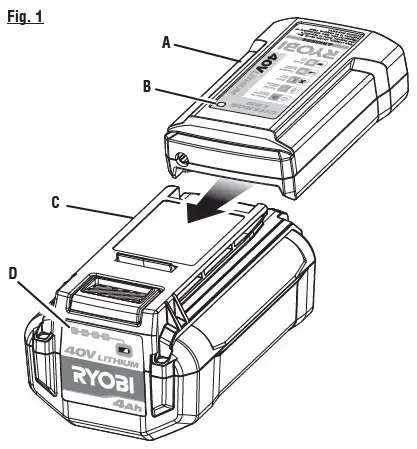
A – DC outlet (sortie CC, salida de CC)
B – LED light
C – Power cable
D – Power adaptor (adaptateur de courant, adaptador de corriente)

A – Battery charger (chargeur de piles, cargador de baterías)
B – Charger LED (lampe à DEL, diodo luminiscente)
C – Battery pack (not included) [bloc-piles (non fournie), paquete de baterías (no suministrado)]
D – Battery pack LEDs (DEL de bloc-pile, diodo luminiscente de paquete de baterías)

A – Power cable (câble d’alimentation, cable de alimentación)
B – DC outlet (sortie CC, salida de CC)
See Figures 1 – 2, page 7.
Battery packs are shipped in a low-charge condition. Therefore, you should charge them before first use. If the charger does not charge your battery pack under normal circumstances, return both the battery pack and charger to your nearest repair center for an electrical check.
Charge time varies and is dependent upon the amp-hour capacity of battery pack.
- Turn the battery pack upside down so that the latch faces up.
- Attach the charger to the battery pack by aligning the raised ribs on the battery pack with the grooves in the charger, then slide the charger onto the battery pack.
NOTE: The connection between the battery pack and charger may feel slightly loose. This is normal and does not indicate a problem. - Press down on the charger to be sure contacts on the battery pack engage properly with contacts in the charger.
- The latch should snap into place to ensure charger is correctly connected.
- Connect the power adaptor to a power source, then connect the power cable to the charger.
NOTE: Make sure the power supply is normal household voltage, 120 volts, AC only, 60 Hz. - Do not place the charger in an area of extreme heat or cold. It will work best at normal room temperature.
- The battery pack will become slightly warm to the touch while charging. This is normal and does not indicate a problem.
- The LED will slowly flash green while the battery pack is charging.
NOTE: If the LED flashes green and red, the charger has detected a fault. See LED Functions for Battery Charging for details. - After charging is complete, the charger LED will stop flashing and remain green for approximately 5 minutes. All battery pack LEDs will turn off to indicate that the battery pack is 100% charged.
- To remove the battery pack from the charger, depress the latch and slide the charger off the battery pack.
- Remove the power adaptor from the power source. Store charger in a dry location.
CHARGING A HOT BATTERY PACK
When using a tool continuously, the battery pack may become hot. The charger may be placed directly onto a hot battery pack but charging will not begin until the battery temperature cools to within an acceptable temperature range. When the charger is placed on a hot battery pack the LED will turn orange and remain on. When the battery pack cools, the charger will automatically begin charging.
CHARGING A COLD BATTERY PACK
The charger may be placed directly onto a cold battery pack but charging will not begin until the battery temperature warms to within an acceptable temperature range. When the charger is placed on a cold battery pack the LED will turn orange and remain on. When the battery pack warms the charger will automatically begin charging.
LED FUNCTIONS FOR BATTERY CHARGING
See Figure 2, page 7.

MAINTENANCE
WARNING:
When servicing, use only identical replacement parts. Use of any other parts could create a hazard or cause product damage.
- To avoid serious personal injury, always remove the battery pack from the product when cleaning or performing any maintenance.
GENERAL MAINTENANCE
Avoid using solvents when cleaning plastic parts. Most plastics are susceptible to damage from various types of commercial solvents and may be damaged by their use. Use clean cloths to remove dirt, dust, oil, grease, etc.
WARNING:
Do not at any time let brake fluids, gasoline, petroleum-based products, penetrating oils, etc., come in contact with plastic parts. Chemicals can damage, weaken or destroy plastic which could result in serious personal injury.
STORAGE
Always remove the battery pack before storing the charger or any time the charger is unplugged.
This product has a Three-year Limited Warranty.
For Warranty details go to www.ryobitools.com
NOTE: MAINTENANCE INFORMATION BEGINS ON PAGE 6
AFTER FRENCH AND SPANISH LANGUAGE SECTIONS.
ILLUSTRATIONS START ON PAGE 7.
TTI OUTDOOR POWER EQUIPMENT, INC.
P.O. Box 1288, Anderson, SC 29622, USA
1-800-525-2579 • TTI OUTDOOR POWER EQUIPMENT, INC.
P.O. Box 1288, Anderson, SC 29622, USA
1-800-525-2579 • www.ryobitools.com
